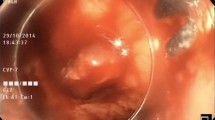Abstract
Background
Dieulafoy lesion is a rare but serious cause of gastrointestinal system bleeding. An aberrant submucosal artery, which was described in 1884, causes the bleeding. The lesion can be located anywhere in the gastrointestinal tract but is most commonly found in the proximal stomach up to 6 cm from the gastroesophageal junction. Increased experience in endoscopy has led to an increased frequency of its proper diagnosis. Various methods are used to achieve successful hemostasis by endoscopy in Dieulafoy lesion; however, comparative studies about the success rates of these methods are still needed. In this study, we compared two of these endoscopic hemostatic methods: band ligation, and injection therapy in Dieulafoy lesions.
Methods
In this prospective study, 18 patients admitted to the Emergency Surgical Unit between January 2002 and December 2005 with upper gastrointestinal bleeding diagnosed as Dieulafoy lesion were included. Diagnose of Dieulafoy lesion was made at initial or second-look endoscopy. Patients were randomized in two groups according to therapy method: injection therapy and band ligation groups. Therapy was applied immediately after recognizing the lesion at the same endoscopic procedure. Two groups were compared regarding demographical data, presence of comorbid diseases, history of medication and previous gastrointestinal system bleeding, hemodynamic status, laboratory values, need for transfusion, endoscopic findings, success rate of the treatment method, mean hospital stay, complications, and recurrence of bleeding.
Results
Of 588 patients admitted with upper gastrointestinal hemorrhage, Dieulafoy lesion was recognized in 18 cases (3.1%) at initial or second-look endoscopy. All patients were men with a mean age of 62.8 (range, 30–80) years. Band ligation was applied to ten patients and the remaining eight were treated by injection therapy. During the follow-up period, rebleeding occurred in six of the patients (75%) with injection therapy, whereas no rebleeding occurred for the patients in the band ligation group. The rebleeding rate and mean hospital stay was significantly higher for the injection therapy group.
Conclusions
Our study suggests that of the endoscopic treatment methods, band ligation is superior to injection therapy for the treatment Dieulafoy lesions.
Similar content being viewed by others
References
Schmulewitz N, Baillie J (2001) Dieulafoy lesions: a review of 6 years of experience at a tertiary referral center. Am J Gastroenterol 96:1688–1694
Koyuncu A, Lice H, Arikan S et al (2003) Dieulafoy’s disease as a cause of massive upper gastrointestinal hemorrhage. Ulus Travma Acil Cerrahi Derg 9:140–142
Peumery JJ (2004) Georges Dieulafoy (1839–1911) and the teaching of medicine in Paris at the hinge of the Second Empire and the Third Republic. Vesalius 10:74–77
Yarze JC (2001) Routine endoscopic “marking” of Dieulafoy-like lesions. Am J Gastroenterol 96:264–265
Norton ID, Peterson BT, Sorbi D et al (1999) Management and long-term prognosis of Dieulafoy lesion. Gastrointest Endosc 50:762–767
Levy MJ, Kee Wong, Song LM et al (2008) Endoscopic ultrasound (EUS)-guided angiotherapy of refractory gastrointestinal bleeding. Am J Gastroenterol 103:352–359
Durham JD, Kumpe DA, Rothbarth LJ et al (1990) Dieulafoy disease: arteriographic findings and treatment. Radiology 174:937–941
Linhares MM, Filho BH, Schraibman V et al (2006) Dieulafoy lesion: endoscopic and surgical management. Surg Laparosc Endosc Percutan Tech 16:1–3
Sone Y, Kumada T, Toyoda H et al (2005) Endoscopic management and follow-up of Dieulafoy lesion in the upper gastrointestinal tract. Endoscopy 37:449–453
Adler DG, Leighton JA, Davila RE et al (2004) ASGE guideline: the role of endoscopy in acute non-variceal upper-GI hemorrhage. Gastrointest Endosc 60:497–504
Cheng CL, Liu NJ, Lee CS et al (2004) Endoscopic management of Dieulafoy lesions in acute nonvariceal upper gastrointestinal bleeding. Dig Dis Sci 49:1139–1144
Yanar H, Dolay K, Ertekin C et al (2007) An infrequent cause of upper gastrointestinal tract bleeding: “Dieulafoy’s lesion”. Hepatogastroenterology 54:1013–1017
Brown GR, Harford WV, Jones WF (1994) Endoscopic band ligation of an actively bleeding Dieulafoy lesion. Gastrointest Endosc 40:501–503
Lee BI, Kim BW, Choi H et al (2003) Hemoclip placement through a forward viewing endoscope for a Dieulafoy-like lesion in a duodenal diverticulum. Gastrointest Endosc 58:813–814
Park CH, Joo YE, Kim HS et al (2004) A prospective randomized trial of endoscopic band ligation versus endoscopic hemoclip placement for bleeding gastric Dieulafoy’s lesions. Endoscopy 36:677–681
Xavier S (2005) Band ligation of Dieulafoy lesions. Indian J Gastroenterol 24:114–115
Mumtaz R, Shaukat M, Ramirez FC (2003) Outcomes of endoscopic treatment of gastroduodenal Dieulafoy’s lesion with rubber band ligation and thermal/injection therapy. J Clin Gastroenterol 36:310–314
Valera JM, Pino RQ, Poniachik J et al (2006) Endoscopic band ligation of bleeding dieulafoy lesions: the best therapeutic strategy. Endoscopy 38:193–194
Yen HH, Chen YY (2006) Endoscopic band ligation for Dieulafoy lesions: disadvantages and risks. Endoscopy 38:651
Author information
Authors and Affiliations
Corresponding author
Rights and permissions
About this article
Cite this article
Alis, H., Oner, O.Z., Kalayci, M.U. et al. Is endoscopic band ligation superior to injection therapy for Dieulafoy lesion?. Surg Endosc 23, 1465–1469 (2009). https://doi.org/10.1007/s00464-008-0255-8
Received:
Revised:
Accepted:
Published:
Issue Date:
DOI: https://doi.org/10.1007/s00464-008-0255-8




